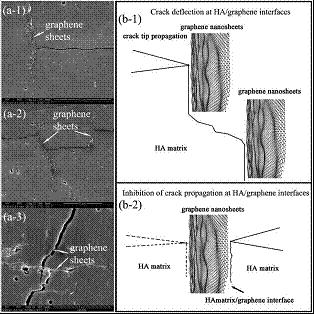New biomaterial development and bioceramic toughening research progresses
Bio-ceramic material, hydroxyapatite, has been successfully applied to orthopaedic operations such as bone tissue fixation because it is similar to the natural composition of human bones.
And hydroxyapatite can be directly fixed with the host bone tissue, has excellent bone conduction and osteoinductive properties, prompting its clinical application has obvious advantages over other ceramic biomaterials. However, the inherent brittleness of hydroxyapatite blocks and their low fracture toughness limit their long service life under post-operative loads.
Therefore, the development of a bioceramic material with excellent biological properties and mechanical properties is the current frontier of biomaterial research.
The Li Hua team of the Ningbo Institute of Materials Technology and Engineering of the Chinese Academy of Sciences recently developed a new type of hydroxyapatite-graphene nanocomposite bio-block to solve the problem of toughening of ceramic bio-materials that has existed for a long time. The results were published in the Journal of Materials Chemistry B, a journal of the Royal Society of Chemistry (Mater. Chem. B 2013, 1, 1826-1834).
Li Hua team used chemical co-precipitation method to synthesize hydroxyapatite-graphene nanocomposite powder, and used plasma discharge sintering to prepare ceramic biomaterials. The hydroxyapatite is nucleated and grown along the surface of the graphene sheet in a certain orientation. Due to lattice matching factors, the hydroxyapatite (300) plane preferentially forms a strong bond on the surface of the graphene sheet, and the (002) plane preferentially binds closely to the side section of the graphene sheet.
These structural features are conducive to enhancing the mechanical properties of composites. The fracture toughness of hydroxyapatite-graphene nanocomposite bulk material prepared by spark plasma sintering is 3.94 MPa×m1/2, which is 203% higher than that of pure hydroxyapatite bulk, and is obviously higher than that of other second phase materials such as carbon. Toughening effect of hydroxyapatite, such as nanotubes, zirconia or metallic titanium.
The toughening principle is mainly that the graphene is evenly distributed in the hydroxyapatite matrix, and mainly formed fine grain toughening, graphene sheet pull out/stretch toughening, crack deflection toughening, micro cracks toughening, and Bridge strengthening and other strengthening mechanisms. The study of the submicron-level toughening mechanism solves the long-standing problem of toughening of bioceramic materials, which involves solving the problem of improving the mechanical properties of the second phase without sacrificing the biological properties.
The team's researchers characterized the in vitro biological properties of the biomaterial and found that graphene not only has no biological toxicity, but also promotes attachment, adhesion, and proliferation and differentiation of osteoblasts on the surface of the material. The optimized mechanical properties and biological properties of the material mean that the composite biomaterial is expected to find application in the biomedical field.
Surface modification of materials such as nanostructures and the addition of new graphene materials greatly improve the biological properties of hydroxyapatite bioceramics. The underlying mechanism remains to be further studied by researchers.
The team's future research work will focus on the study of biological material/cell interface behaviors. The research will involve the study of the attachment of serum proteins based on the molecular level. It is hopeful that the interaction mechanism between cells and biological materials will be revealed in order to improve predictions. And the ability to control the biocompatibility of new biological materials.
This study was supported by the National Natural Science Foundation of China (project approval No. 31271017) and the "100-person plan" of the Chinese Academy of Sciences.

Graphene surface hydroxyapatite preferential orientation nanorod nucleation and growth and formation of natural tight junction interface

Graphene sheets effectively inhibit crack propagation in hydroxyapatite matrix
Hdmi Microscope Camera ,Hdmi Microscope ,Microscope Hdmi Camera,Digital Microscope With Hdmi Output
Ningbo Beilun Kalinu Optoelectronic Technology Co.,Ltd , https://www.kalinueot.com